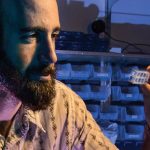Scientists have unraveled how mutant molecules damage the nervous system of people with Charcot-Marie-Tooth (CMT) disease, a group of disorders that hinder people’s ability to move and feel sensation in their hands and feet, according to a paper co-led by Samuel Pfaff. The team used a range of neurogenetic, gene therapy, biochemical and structural biology research techniques to discover that the mutant GlyRS enzyme blocked molecular signals important for maintaining the health of motor neurons. The findings suggest a possible avenue for developing new therapies for CMT.
Read News Release
Nature
10/2015























































